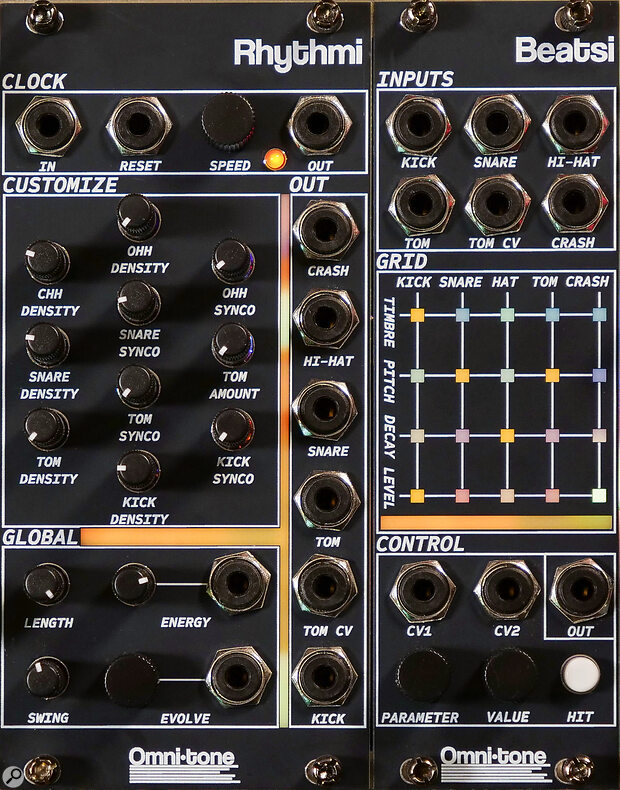From Omnitone of Canada, we have a pair of colourful rhythm‑makers that can operate separately, or as a percussive pair. Rhythmi is a pattern and trigger generator with an interesting angle on groove generation. Beatsi is a digital drum synthesizer rolled into a compact grid of easy access sound‑shaping. Both employ a slightly cryptic use of colour to show activity and value, giving the modules a unique style and workflow.
Rhythmi
Rhythmi is not a sequencer as such; rather, it is an explorer of patterns that’s reminiscent of Mutable Instruments’ Grids. It has five channels: kick, snare, hi‑hat, tom and crash, and it comes up with an open hi‑hat by lengthening the hi‑hat gate output. A pattern can go from two to 32 steps and from stripped‑back laziness to full‑on mania.
You have a choice of five unique base patterns. These are influenced in the quite crowded Customise section by the Density knobs, which increase the number of hits, and Synco knobs, which define how often they are on or off the beat. The crash is different; it just triggers when the pattern energy is high enough. Once set you can then turn the Energy knob to make everything faster and harder, and spin the Evolve encoder to branch off into variations. It’s busy, exciting and full of surprises, which is not always what you want, but once you’ve accepted that you are not entirely in control, it’s a fun ride.
Beatsi
Meanwhile, Beatsi is dutifully pumping out a corresponding collection of sounds. It has three kits: orange is acoustic, blue is lo‑fi, and green is an alien kit, although those labels shouldn’t be taken too seriously. There are individual inputs for each of the five channels and a pitch input for the toms. The toms are a bit of a special feature in that Rhythmi has a Tom 1V/oct CV output that can play a tune on the tom sound in the Beatsi, which is very cool. Otherwise, there’s a single mixed output and everything else is done in the grid.
You use the Parameter encoder to zip through the 5x4 grid one node at a time. The colour band at the bottom gives you a rough idea of the value and changes colour to show which kit you’re in. The grid gives you control over pitch, level and decay, and you can also assign parameters to the two CV inputs. Once you’ve figured it out, it’s really quite powerful, if a bit laborious, but so much more preferable to fiddling around with a menu and values on a little display.
You don’t have to use these two modules together, although they do make a great combo.
You don’t have to use these two modules together, although they do make a great combo. Beatsi would make for an interesting and compact drum module for anyone into synthetic percussion. Rhythmi offers programming‑free drum patterns with lots of variation for small adjustments and is so engrossing that you can forget to do anything else with your patch. The coloured interface is delightful but can be a bit mysterious, while Rhythmi in particular feels busy in form and function. However, there’s a little universe of rhythms and weird sounds in here that offer lots of fun, unexpected avenues and an alternative to programming and probability.

